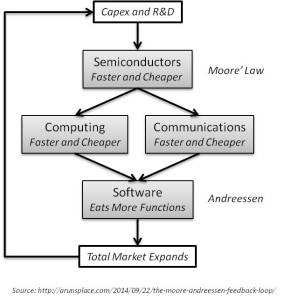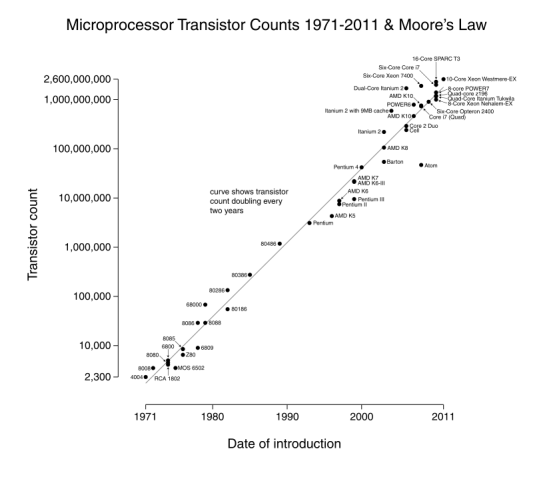This post combines two famous but separate observations, made 46 years apart, about technology advances into a single integrated feedback loop that I think has been the major source of disruptive creation in the world over the last fifty years; it still continues, unabated, today.
- Moore’s Law: This is not really a law in the sense of scientific laws of nature; rather, it is a prescient observation made by in 1965 Intel’s co-founder Gordon Moore on the exponential pace of change in the semiconductor industry. He noticed that the transistor count in semiconductors seems to double every couple of years. Surprisingly, his observation continues to be valid more than 49 years after he first made it. This relentless advance has been like a giant clock that drives the entire technology industry forward every year.
- Venture capitalist Marc Andreessen’s observation (first made, I think, on the pages of WSJ in 2011) that “software is eating the world” trenchantly captures the fact that software replaces more and more functions that were formerly performed by humans or physical machines with every passing year. This is also a relentless advance that feels like a force of nature in its power to disrupt.
Moore’s Law is the result of human ingenuity and hard work fueled by ever rising capital expenditure and R&D on semiconductor fabrication processes. Each advance has required major breakthroughs at the level of material science, industrial processes, and applied quantum physics. Amazingly, such advances have indeed been made just in time to preserve the cadence of the “law” for over four decades. The following graphic captures the fact that the number of transistors found on a chip has been doubling every two years — i.e., growing at more than 40% per year!
But the “ante” in terms of capex and R&D dollars needed for such complex advanced rises every year. Intel, Samsung, Taiwan Semiconductor, et al are nowadays spending ten-plus billion dollars every year to keep the semiconductor manufacturing process advances coming. So where are the returns needed to fund these investments coming from?
This is where the crucial role played by software comes in. As it becomes more and more capable, it can do more and more (a tautology!) thus expanding the market for semiconductors. And the expanding semiconductor market, in turn, justifies an increase in the investments needed for the capex and R&D required for driving Moore’s law forward.
There are two parallel channels that allow software to become more and more capable as a result of better semiconductors: better and cheaper computing and better and cheaper communications. Think of the speed and cost of today’s internet and speed and cost of today’s smartphones as compared to the slow modem lines and slow and clunky computers of even a decade ago. Both these advances are synergistic and are critical enablers of the advances in programming techniques and tools needed for software to eat more of the world.
As software captures more functions it expands the market for computers and communications. Nearly 2 billion people already have the powerful supercomputers in their pockets known as smartphones, and serious projections are suggesting the possibility of 4 to 5 billion people having smartphones communicating with each other and running powerful apps in the next few years.
Every part of the loop sketched at the top of this post is important, and mutually supportive, to all the other parts:
- Software, by itself, cannot advance at 40% per year type rates without improved hardware to run on and improved networking speeds. The major advances in software tools — from assembly coding to higher level languages to object-oriented languages, from waterfall to Agile programming techniques — are all fundamentally enabled by faster computing speeds provided by the underlying hardware.
- Computers by themselves will completely starve of data-to-compute if the speed and reach of communication pipes linking them together did not advance along with them. Imagine connecting your super-powerful, instant-on, tablet to any of the slow dial-up modems of the old days!
- The massive capex in semiconductors needed for improving both computers and communications cannot be justified without the expanded market provided by software eating more of the world.
- And so on; all components of this positive feedback loop have to advance together, mutually re-enforcing each other, to keep it going.
Scaling the Power of the Loop
The scale of this phenomenon is not that easy to grasp. In personal conversations, people nod knowingly, thinking that all I am saying is that technology progresses every year, and of course it does. However, that is not my point at all. There is probably no other phenomenon, natural or artificial, that has shown this kind of exponentially fast growth such an extended period of time. I can safely claim this because of the unusual power of compounding: if anything has been compounding at this high a rate for so many decades, we would see it nearly everywhere already today!
To appreciate the stupefying scale of the phenomenon, let me contrast it to another technological revolution.
During the Industrial Revolution, that supernova of all changes in the human condition, growth in Western Europe accelerated by a puny 1% per year! Even this tiny amount though, when steadily compounded for a hundred years (most historians date the Industrial Revolution roughly between 1750 to 1850), resulted in a massive improvement in living standards from the complete lack of growth for the thousands of years before it (see the zero net growth in income per person for thousands of years on the left of the Industrial Revolution, during the so-called “Mathusian Trap” period, in the graphic below; source: figure 1.1 from a recent book on this subject by economic historian Gregory Clark).
So if the Industrial Revolution changed the world so dramatically with a mere 1% growth compounded for a hundred years, consider the relative impact on the world affected by Moore’s Law, which has compounded at over 40% per year for nearly 50!
Anything growing at this blistering pace should become millions of times better (faster/cheaper) in only a few decades, and indeed our computers do show exactly such improvement – that smartphone in our pocket really is more than a million times more powerful than the most powerful computer on the planet from fifty years ago. It is hard to think of many other examples that show such an astounding growth pattern; and the examples that do come to mind seem to be, in one way or another, intersected and transformed by the power of the Moore-Andreessen loop. Try thinking of a counter-example!
Shift in Scarcity
This sort of massive change can cause a fundamental shift in what is scarce and what is abundant every few years. In my opinion, it is this frequent shift in the point of scarcity that has been the real driver of the constant disruption that characterizes our information age. As if an avatar of the ancient god Shiva of Hindu mythology, who is said to destroy in order to create anew, this loop is a powerful force of disruptive-creation: companies that are better aligned with this loop can — and often do — replace incumbent companies that are slower in adapting to its consequences.
A corollary: SoCs are eating the surrounding chips
A phenomenon that is strikingly similar to “software eating the world” seems to be happening right within the motherboard of all the smartphones and tablets and laptops. A “System on a Chip” (abbreviated SOC or SoC), as the name implies, contains a whole system of modules on one silicon chip by absorbing more and more functions that were formerly performed by independent chips. Functions such as graphics, modems, DSP, and various kinds of memory have already been absorbed.
I think the abandonment of the baseband chip market by Texas Instrument and Broadcom is the latest example of this corollary phenomenon. The baseband function now forms just a piece of a larger SoC chip produced by companies like Qualcomm, Mediatek, and Intel. The economics of producing them as part of an integrated SoC became increasingly tilted in their favor compared to the baseband function chips made by TI and Broadcom until the latter finally got eaten up.
I see this as a trend powered by essentially the same kind of loop as diagrammed above, with Moore’s law shrinking the size of semiconductors and interconnection technologies with every new generation when combined with the ever-growing power of chip design software. The expanded market (e.g., billions of smartphones and perhaps tens of billions of “internet of things” devices) enabled by the resulting SoCs fuels the necessary investments in capex and R&D, completing the loop.
Disclosure: I am long Qualcomm and Intel in various portfolios at the time this post was written.



Pingback: The Challange of Value Investing as Software Eats the World | ArunsPlace
Pingback: Quick links (#21) | Urban Future (2.1)
Pingback: Shifts in Scarcity Drives Disruption, Bundling, and Unbundling | ArunsPlace